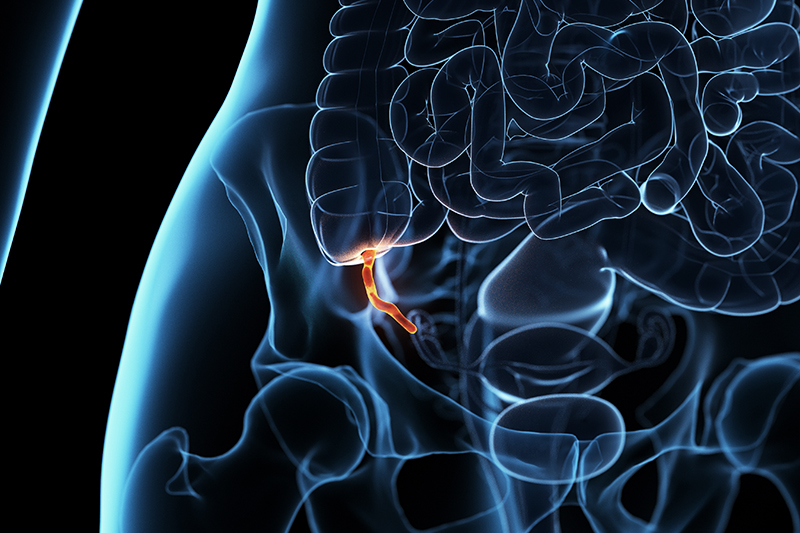Appendicitis is an inflammation of the appendix which is a finger-shaped pouch that projects from colon on the lower right side of the abdomen. Appendicitis is one of the most common diseases presented with acute and severe abdominal pain. It can actually strike anyone at any age, although it is primarily common between ages 12-60.
Since acute symptoms of appendicitis are frequently similar to other abdominal ailments such as peptic ulcer and gastritis, differential diagnosis might be delayed, resulting in serious complications. Early diagnosis with full physical examinations substantially helps to provide effective treatments which reduce disease severity and possible complications. If appendicitis is suspected. immediate medical care is highly advised.
Get to know appendicitis
Appendicitis is an inflammation of the appendix which is a finger-shaped pouch that projects from colon on the lower right side of the abdomen. The appendix doesn’t seem to have a specific function. Major cause of appendicitis is a blockage in the lining of the appendix. Causes of blockage might include fecal impaction in the appendix and enlarged lymph nodes in the appendix areas, leading to distension, increased intraluminal pressure with subsequent mural invasion by intraluminal bacteria, resulting in infections. Subsequently, pathogenic bacteria multiply rapidly and cause the appendix to become inflamed, swollen and filled with pus. If it is not treated promptly, appendicitis can cause serious complications such as a pocket of infection (abscess) and a ruptured appendix which spreads infection throughout abdomen (peritonitis).
Signs and symptoms of appendicitis
Signs and symptoms of appendicitis during initial phase may include nausea and vomiting, loss of appetite and sudden pain that cannot be pinpointed. During this phase, acute appendicitis could be misdiagnosed due to these presented symptoms are considerably similar to other diseases that also manifest abdominal pains with different pain characteristics such as epigastric pain in the area of the upper abdomen, frequent sharp pain like peptic ulcer attack, dull pain around the umbilical area, diarrhea-like squeezing or spasm pain without diarrhea. Abdominal pain often radiates from central to lower right abdomen. In some cases, abdominal pain in the lower right abdomen might be initially presented. Oral medicines do not cure appendicitis. Pain gets worse while walking or making jarring movements as the illness progresses.
Diagnosis of appendicitis
If abdominal pain lasts longer than 6 hours, immediate medical attention must be provided. Tests and procedures used to diagnose appendicitis include:
- Taking a medical history of signs and symptoms and examining the abdomen including abdominal rigidity and a tendency.
- Blood tests (CBC: complete blood count) for checking the level of white blood cell count. Higher level may indicate an infection.
- Urine test (urinalysis) and hemodynamic tests to differentiate other conditions.
- Imaging tests such as abdominal ultrasound, computerized tomography (CT) scan or magnetic resonance imaging (MRI) to help confirm appendicitis or find other causes of abdominal pain.
Treatment of appendicitis
Most appendicitis cases require surgery. To surgically remove appendix, it is called appendectomy. There are two types of appendectomy: open appendectomy and laparoscopic appendectomy. The latter has increasingly been used due to its superior benefits in appendicitis without ruptures. In comparison to open appendectomy which open cut is required, laparoscopic appendicitis is a minimally invasive surgery to remove the appendix through small incisions. Surgeons operate through these small incisions by insertion of surgical instrument and surgical camera (laparoscope) while watching the enlarged images of the internal organs on a monitoring screen. Currently, laparoscopic appendectomy is usually the preferred method due to smaller incisions, less blood loss, less pain and scarring, faster recovery time and a quick return to daily life as well as the reduced risks of post-operative complications such as lowered rates of infection.
Apart from highly skilled and experienced surgeons specialized in laparoscopic procedures, advanced surgical technology plays a crucial role to achieve the best possible surgical outcomes. Advanced 3D laparoscopic surgery allows surgeons to perform procedures with greater speed and more accuracy as well as the improvement of surgical outcomes. The laparoscopic camera is attached with 2 high definition lens. With the use of the latest 3D laparoscopic surgical system, surgeons wearing 3D glasses can view the procedure on a high resolution video monitor with full HD, natural 3D vision and depth perception. Due to the advancements in laparoscopic instrument with 4K Ultra High Definition, it enables surgeons to clearly visualize the surgical field in the abdominal cavity including internal organs, blood vessels and nerves which is displayed on 55-inch surgical monitor screen. In comparison to previous Full HD version, as a consequence, it helps enhancing surgical accuracy and promoting more safety to surrounding areas.
Nevertheless, laparoscopic appendicitis might be only considered in patients with ruptured appendix presented with only abdominal pain at the lower right side, without radiation to the left side of abdomen. If there are suspicious signs of appendix bursts causing the infection spreads in the abdomen and possibly throughout the body and resulting in sepsis, open appendicitis might become the first-line treatment.
In case of appendicitis perforated with abscess (a pocket of infection, filled with pus), normally diagnosed with CT scan, a surgeon cleans the abdominal cavity and drains the abscess by placing a tube through the abdominal wall into the abscess. The tube is left in place for certain period of time with prescribed antibiotics to clear the infections. After controlling the infections, laparoscopic appendectomy can be subsequently performed. It largely helps minimizing the chances of bowel resections when severe infection is indicated. In some cases, the abscess is drained and the appendix is removed immediately. However, the complexity of laparoscopic procedure is principally determined by the position of the appendix and its presented complications.
Appendicitis is frequently overlooked. Since abdominal pain is not a specific symptom, patients commonly misunderstand that only taking medicines e.g. pain killer tablets and antibiotic drugs help to treat their condition. Although in some patients, these drugs help alleviating their symptoms but only temporarily. Without accurate diagnosis, symptoms usually progress with the presence of pus or abscess which is the main condition that urges patient to seek immediate medical attention. If abdominal pain persists, taking medicines is not recommended. If appendicitis is suspected particularly with abdominal pain that shifts to lower right abdomen, immediate medical care is highly advised.










